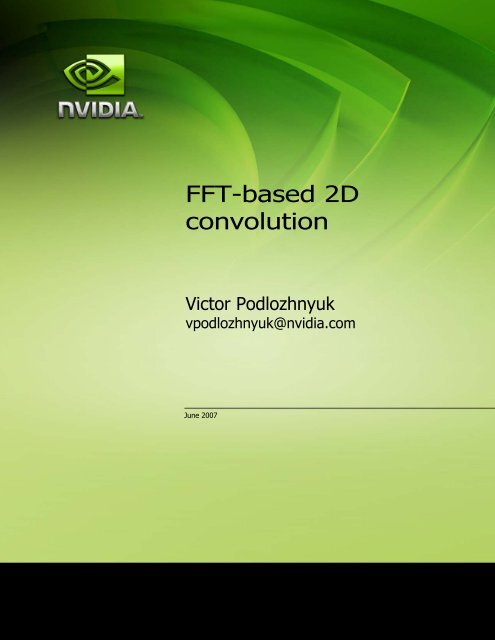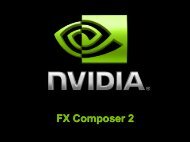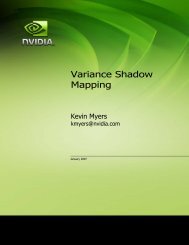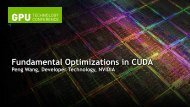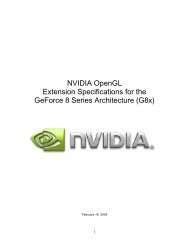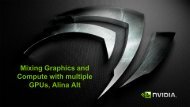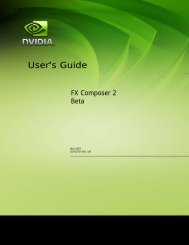FFT-based 2D convolution - Nvidia
FFT-based 2D convolution - Nvidia
FFT-based 2D convolution - Nvidia
Create successful ePaper yourself
Turn your PDF publications into a flip-book with our unique Google optimized e-Paper software.
<strong>FFT</strong>-<strong>based</strong> <strong>2D</strong><br />
<strong>convolution</strong><br />
Victor Podlozhnyuk<br />
vpodlozhnyuk@nvidia.com<br />
June 2007
Document Change History<br />
Version Date Responsible Reason for Change<br />
1.0 2007/06/01 vpodlozhnyuk Initial release<br />
June 2007
Abstract<br />
This sample demonstrates how general (non-separable) <strong>2D</strong> <strong>convolution</strong> with large<br />
<strong>convolution</strong> kernel sizes can be efficiently implemented in CUDA using CU<strong>FFT</strong> library.<br />
NVIDIA Corporation<br />
2701 San Tomas Expressway<br />
Santa Clara, CA 95050<br />
www.nvidia.com
Introduction<br />
The whitepaper of the <strong>convolution</strong>Separable CUDA SDK sample introduces<br />
<strong>convolution</strong> and shows how separable <strong>convolution</strong> of a <strong>2D</strong> data array can be efficiently<br />
implemented using the CUDA programming model. However, the approach doesn’t extend<br />
very well to general <strong>2D</strong> <strong>convolution</strong> kernels. In such cases, a better approach is through<br />
Discrete Fourier Transformation. This latter approach is <strong>based</strong> on the theorem, central to<br />
Digital Signal Processing applications, that <strong>convolution</strong> in geometric space amounts to<br />
point-wise multiplication (modulation) in frequency space. Therefore, given an efficient<br />
direct/inverse Discrete Fourier Transformation implementation, Fourier-<strong>based</strong> <strong>convolution</strong><br />
can be more efficient than a straightforward implementation.<br />
Implementation Details<br />
Fast Fourier Transformation (<strong>FFT</strong>) is a highly parallel “divide and conquer” algorithm for<br />
the calculation of Discrete Fourier Transformation of single-, or multidimensional signals. It<br />
can be efficiently implemented using the CUDA programming model and the CUDA<br />
distribution package includes CU<strong>FFT</strong>, a CUDA-<strong>based</strong> <strong>FFT</strong> library, whose API is modeled<br />
after the widely used CPU-<strong>based</strong> “<strong>FFT</strong>W” library.<br />
The basic outline of Fourier-<strong>based</strong> <strong>convolution</strong> is:<br />
• Apply direct <strong>FFT</strong> to the <strong>convolution</strong> kernel,<br />
• Apply direct <strong>FFT</strong> to the input data array (or image),<br />
• Perform the point-wise multiplication of the two preceding results,<br />
• Apply inverse <strong>FFT</strong> to the result of the multiplication.<br />
However, there are some issues that need to be taken into account:<br />
1) The DSP theorem applies to input data (both the image and the <strong>convolution</strong> kernel) of<br />
same size. Therefore, assuming the image is bigger than the <strong>convolution</strong> kernel, which is<br />
usually the case in practice, the <strong>convolution</strong> kernel needs to be expanded to the image<br />
size and padded according to Figure 1. As can be seen on figures 2 and 3 (see below),<br />
cyclic <strong>convolution</strong> with the expanded kernel is equivalent to cyclic <strong>convolution</strong> with<br />
initial <strong>convolution</strong> kernel.<br />
June 2007
Figure 1. Expansion of the <strong>convolution</strong> kernel to the image size: cyclically shift the<br />
original <strong>convolution</strong> kernel, so that the central element of the kernel is at (0, 0)<br />
2) The <strong>FFT</strong> “performs” cyclic <strong>convolution</strong>: The <strong>convolution</strong> kernel wraps around image<br />
borders in both dimensions. Figure 2 illustrates the <strong>convolution</strong> computation in the nonborder<br />
case – that is when the kernel does not cross any image borders – and Figure 3<br />
illustrates the same computation in the border case for a cyclic <strong>convolution</strong>.<br />
Figure 2. Cyclic <strong>convolution</strong>: non-border case<br />
Figure 3. Cyclic <strong>convolution</strong>: border case.<br />
June 2007
However, most image processing applications require a different behavior in the border case:<br />
Instead of wrapping around image borders the <strong>convolution</strong> kernel should clamp to zero or<br />
clamp to border when going past a border. For the Fourier-<strong>based</strong> <strong>convolution</strong> to exhibit a clamp<br />
to border behavior, the image needs to be expanded and padded in both dimensions as<br />
illustrated in Figures 4, 5, 6, and 7. The <strong>convolution</strong> kernel just needs to be adjusted to the<br />
new padded sizes (fftW, fftH) as illustrated in Figure 1.<br />
0<br />
1<br />
2<br />
3<br />
4<br />
5<br />
6<br />
7<br />
8<br />
9<br />
0<br />
1<br />
dataW >= kernelW – kernelX - 1<br />
5 4 3 2 1 0 7 3 2 4<br />
0 2 0 3 0 4 0 5 0 6<br />
1 0 2 0 3 0 4 0 5 0 6<br />
1 0 2 0 3 0 4 0 5 0 6<br />
9<br />
8<br />
7<br />
6<br />
5<br />
4<br />
3<br />
2<br />
1<br />
0<br />
9<br />
8<br />
8<br />
8<br />
8<br />
7<br />
6<br />
5<br />
4<br />
3<br />
2<br />
1<br />
0<br />
9<br />
8<br />
9<br />
8<br />
7<br />
6<br />
5<br />
4<br />
3<br />
2<br />
1<br />
0<br />
9<br />
8<br />
8 8<br />
8 8<br />
0 5 4 3 2 1 0 7 31 20<br />
4 9 9 9 0 0 0<br />
0 5 4 3 2 1 0 7 31 20<br />
4 9 9 9 0 0 0<br />
0 5 4 3 2 1 0 7 31 20<br />
4 9 9 9 0 0 0<br />
fftW<br />
9<br />
0<br />
1<br />
2<br />
3<br />
4<br />
5<br />
6<br />
7<br />
8<br />
9<br />
0<br />
1<br />
0<br />
1<br />
2<br />
3<br />
4<br />
5<br />
6<br />
7<br />
8<br />
9<br />
0<br />
1<br />
0<br />
1<br />
2<br />
3<br />
4<br />
5<br />
6<br />
7<br />
8<br />
9<br />
0<br />
1<br />
1 1 1<br />
1 1 1<br />
Figure 4. Cyclic <strong>convolution</strong> of the padded image: left border case. Wrapped around<br />
kernel elements get multiplied by correct data value (pixels).<br />
Figure 5. Cyclic <strong>convolution</strong> of the padded image: right border case. Wrapped<br />
around kernel elements get multiplied by correct data values (pixels).<br />
June 2007
Figure 6. Cyclic <strong>convolution</strong> of the padded image: top border case. Wrapped around<br />
kernel elements are multiplied by correct data values (pixels).<br />
Figure 7. Cyclic <strong>convolution</strong> of the padded image: bottom border case. Wrapped<br />
around kernel elements are multiplied by correct data values (pixels).<br />
Required padding is only kernelW – 1 elements in width and kernelH – 1 elements in height,<br />
but for different data sizes CU<strong>FFT</strong> operates with different speeds and different precision. In<br />
particular, if <strong>FFT</strong> dimensions are small multiples of powers of N, where N varies from 2 to 8<br />
for CU<strong>FFT</strong>, the performance and precision are best. For this reason, we round up each<br />
padded dimension (dataW + kernelW – 1) and (dataH + kernelH – 1) to fftW and fftH<br />
respectively as follows: We round up to the nearest power of two if the padded dimension is<br />
less than or equal to 1024, or only to the nearest multiple of 512 otherwise, in order to save<br />
computations and memory bandwidth, since the per-element computation complexity of the<br />
<strong>FFT</strong> algorithms grows as the sizes of the Fourier transformation increase.<br />
June 2007
Performance<br />
Benchmarking <strong>FFT</strong>-<strong>based</strong> <strong>convolution</strong> is somewhat ambiguous issue to be expressed in a<br />
single rate of filtered pixels per second, since per-element computation complexity of the<br />
underlying <strong>FFT</strong> algorithms depends only on the padded image size, and in its turn padded<br />
image size depends both on the image and <strong>convolution</strong> kernel sizes. For power of two<br />
padded image size (fftW, fftH), effective per-element computation complexity is:<br />
O(<br />
fftW ⋅ fftH ⋅ log( fftW ⋅ ftH ))<br />
≈ O(log(<br />
fftW ) + log( fftH ))<br />
dataW ⋅ dataH<br />
against O(kernelW * kernelH) of a straightforward <strong>convolution</strong> implementation.<br />
Increasing the <strong>convolution</strong> kernel size, still assuming it to be much smaller than of the image<br />
(as usually observed on practice), we can see that the value of the former expression remains<br />
approximately the same, but the value of the latter expression increases proportionally to the<br />
number of elements in the <strong>convolution</strong> kernel. So, for each “big enough” input image size,<br />
starting from certain <strong>convolution</strong> kernel size, <strong>FFT</strong>-<strong>based</strong> <strong>convolution</strong> becomes more<br />
advantageous than a straightforward implementation in terms of performance.<br />
Table below gives performance rates<br />
<strong>FFT</strong> size 256x256 512x512 1024x1024 1536x1536 2048x2048 2560x2560 3072x3072 3584x3584<br />
Execution<br />
time, ms<br />
<strong>FFT</strong><br />
<strong>convolution</strong><br />
rate,<br />
MPix/s<br />
0.75 2.08 6.73 28 42 89 146 178<br />
87 125 155 85 98 73 64 71<br />
So, performance depends on <strong>FFT</strong> size in a non linear way. On average, <strong>FFT</strong> <strong>convolution</strong><br />
execution rate is 94 MPix/s (including padding).<br />
The <strong>2D</strong> <strong>FFT</strong>-<strong>based</strong> approach described in this paper does not take advantage of separable<br />
filters, which are effectively 1D. Therefore, it should not come as a surprise that for<br />
separable <strong>convolution</strong>s, the approach used in <strong>convolution</strong>Separable performs at much higher<br />
rates. The <strong>2D</strong> <strong>FFT</strong>-<strong>based</strong> approach is however the better choice for large non-separable <strong>2D</strong><br />
<strong>convolution</strong>s, for which straightforward shared memory-<strong>based</strong> approaches either do not<br />
perform as well because they require a big apron that introduces too much memory read<br />
overhead, or are simply not applicable because they require more shared memory than is<br />
available<br />
Bibliography<br />
1. Y. A. Romanyuk (2005). “Discrete Signal Transformations”. Basics of Digital Signal<br />
processing. Part 1. Chapter 3.<br />
2. Wolfram Mathworld. “Convolution” http://mathworld.wolfram.com/Convolution.html<br />
June 2007
June 2007<br />
3. Wolfram Mathworld. “Fast Fourier Transform”<br />
http://mathworld.wolfram.com/FastFourierTransform.html
Notice<br />
ALL NVIDIA DESIGN SPECIFICATIONS, REFERENCE BOARDS, FILES, DRAWINGS, DIAGNOSTICS, LISTS, AND<br />
OTHER DOCUMENTS (TOGETHER AND SEPARATELY, “MATERIALS”) ARE BEING PROVIDED “AS IS.” NVIDIA<br />
MAKES NO WARRANTIES, EXPRESSED, IMPLIED, STATUTORY, OR OTHERWISE WITH RESPECT TO THE<br />
MATERIALS, AND EXPRESSLY DISCLAIMS ALL IMPLIED WARRANTIES OF NONINFRINGEMENT,<br />
MERCHANTABILITY, AND FITNESS FOR A PARTICULAR PURPOSE.<br />
Information furnished is believed to be accurate and reliable. However, NVIDIA Corporation assumes no<br />
responsibility for the consequences of use of such information or for any infringement of patents or other<br />
rights of third parties that may result from its use. No license is granted by implication or otherwise under any<br />
patent or patent rights of NVIDIA Corporation. Specifications mentioned in this publication are subject to<br />
change without notice. This publication supersedes and replaces all information previously supplied. NVIDIA<br />
Corporation products are not authorized for use as critical components in life support devices or systems<br />
without express written approval of NVIDIA Corporation.<br />
Trademarks<br />
NVIDIA, the NVIDIA logo, GeForce, NVIDIA Quadro, and NVIDIA CUDA are trademarks or<br />
registered trademarks of NVIDIA Corporation in the United States and other countries. Other<br />
company and product names may be trademarks of the respective companies with which they<br />
are associated.<br />
Copyright<br />
© 2007 NVIDIA Corporation. All rights reserved.<br />
June 2007


